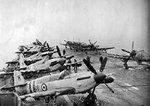stug3
Staff Sergeant
A diagrammatic representation of the damage sustained by USS Yorktown on the 4th June.

The USS Yorktown had been abandoned on the 4th June. When it became apparent that she was not going to sink she was re-boarded and attempts made to bring her under control. The destroyer the USS Hammann came alongside to assist in these operations. It was at this point, with the carrier lying dead in the water that Japanese submarine I-168 struck. One torpedo was to hit the Hammann causing catastrophic damage that quickly sunk her. Two others passed under the Hamman and proved to be the fatal blow for the Yorktown.
USS Hammann (DD-412) sinking with stern high, after being torpedoed by Japanese submarine I-168 in the afternoon of 6 June 1942. Photographed from the starboard forecastle deck of USS Yorktown (CV-5) by Photographer 2nd Class William G. Roy. Angular structure in right foreground is the front of Yorktown's forward starboard 5-inch gun gallery. Note knotted lines hanging down from the carrier's flight deck, remaining from her initial abandonment on 4 June.

A diagrammatic representation of the damage sustained by USS Yorktown on 6th June 1942 when the destroyer USS Hamman was alongside her.

SBD Dauntless dive bombers from USS Hornet (CV-8) approaching the burning Japanese heavy cruiser Mikuma to make the third set of attacks on her, during the early afternoon of 6 June 1942. Mikuma had been hit earlier by strikes from Hornet and USS Enterprise (CV-6), leaving her dead in the water and fatally damaged. Photo was enlarged from a 16mm color motion picture film.

Japanese cruiser Mikuma, photographed from a USS Enterprise (CV-6) SBD aircraft during the afternoon of 6 June 1942, after she had been bombed by planes from Enterprise and USS Hornet (CV-8). Note her shattered midships structure, torpedo dangling from the after port side tubes and wreckage atop her number four eight-inch gun turret.

The USS Yorktown had been abandoned on the 4th June. When it became apparent that she was not going to sink she was re-boarded and attempts made to bring her under control. The destroyer the USS Hammann came alongside to assist in these operations. It was at this point, with the carrier lying dead in the water that Japanese submarine I-168 struck. One torpedo was to hit the Hammann causing catastrophic damage that quickly sunk her. Two others passed under the Hamman and proved to be the fatal blow for the Yorktown.
USS Hammann (DD-412) sinking with stern high, after being torpedoed by Japanese submarine I-168 in the afternoon of 6 June 1942. Photographed from the starboard forecastle deck of USS Yorktown (CV-5) by Photographer 2nd Class William G. Roy. Angular structure in right foreground is the front of Yorktown's forward starboard 5-inch gun gallery. Note knotted lines hanging down from the carrier's flight deck, remaining from her initial abandonment on 4 June.
A diagrammatic representation of the damage sustained by USS Yorktown on 6th June 1942 when the destroyer USS Hamman was alongside her.
SBD Dauntless dive bombers from USS Hornet (CV-8) approaching the burning Japanese heavy cruiser Mikuma to make the third set of attacks on her, during the early afternoon of 6 June 1942. Mikuma had been hit earlier by strikes from Hornet and USS Enterprise (CV-6), leaving her dead in the water and fatally damaged. Photo was enlarged from a 16mm color motion picture film.
Japanese cruiser Mikuma, photographed from a USS Enterprise (CV-6) SBD aircraft during the afternoon of 6 June 1942, after she had been bombed by planes from Enterprise and USS Hornet (CV-8). Note her shattered midships structure, torpedo dangling from the after port side tubes and wreckage atop her number four eight-inch gun turret.



